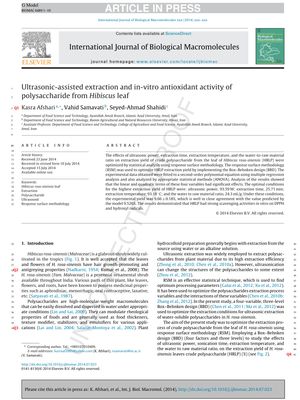Ultrasonic-Assisted Extraction and In-Vitro Antioxidant Activity of Polysaccharide from Hibiscus Leaf
August 2014
in “
International Journal of Biological Macromolecules
”

TLDR The study found an efficient method to extract antioxidants from Hibiscus leaves.
The study optimized the ultrasonic-assisted extraction of polysaccharides from Hibiscus rosa-sinensis leaves and evaluated their in-vitro antioxidant activity. Using response surface methodology with a Box-Behnken design, the optimal extraction conditions were determined to be 93.59 W ultrasonic power, 25.71 min extraction time, 93.18 °C extraction temperature, and a 24.3 mL/g water-to-raw material ratio, resulting in a yield of 9.66±0.18%. This yield closely matched the predicted yield of 9.526%. The extracted polysaccharides showed strong scavenging activities on DPPH and hydroxyl radicals, indicating their potential as antioxidants. The study's statistical analysis revealed a determination coefficient (R²) of 0.9884 and an adjusted R² of 0.9768, confirming the model's accuracy in predicting the extraction process. The scavenging ability of the polysaccharides was comparable to ascorbic acid, suggesting their efficacy as potent antioxidants. The number of experiments or replicates for the optimization was not specified.